In an age where personal safety and defense have become increasingly important, innovative tools and gadgets are emerging to cater to these growing concerns.
Among these inventions is the tactical pen, a seemingly inconspicuous writing device with multifaceted applications. This discreet tool has garnered significant attention, leading many to question its true nature.
Is the tactical pen simply a utility device, or does it cross the line into weaponry? I mean is tactical pen a weapon?
Well, a tactical pen isn’t a weapon a nature, but you may use it as a self-defense tool if need be due to its extensive features.
In this article, we will delve into the various features of tactical pens, their intended uses, and the legal implications surrounding this unique tool, allowing you to make an informed decision about its place in your life and personal safety toolkit.

Is tactical pen a weapon?
At its core, a tactical pen appears to be nothing more than an everyday writing instrument. However, it’s designed with added features and strong materials, making it much more versatile and potentially useful for self-defense.
To answer whether a tactical pen is a weapon, it’s important to consider the various aspects that define a “weapon” and the specific characteristics of a tactical pen itself.
Features of a Tactical Pen
Tactical pens are usually made from durable materials such as aircraft-grade aluminum, stainless steel, or titanium, making them more robust than ordinary pens. These pens have several features that can lead some to consider them as weapons:
- Self-defense tip: One end of a tactical pen typically features a sharp or pointed strike tip for breaking glass or striking an attacker in self-defense. This tip can inflict significant pain or injury if used with force.
- DNA catcher: Some tactical pens have a crown-shaped or jagged edge that can be used to collect DNA samples in case of an attack, which may help identify the assailant later.
- Kubotan: A tactical pen can also function as a kubotan, a self-defense weapon used in martial arts to add power and precision to strikes or to apply pressure on sensitive points for control and compliance techniques.
- Concealed design: Tactical pens are often discreetly designed to look like ordinary pens so they can go unnoticed, allowing the user to carry them without drawing attention.
Legal Aspects
Laws and regulations regarding the possession and use of tactical pens may vary depending on the jurisdiction. In some places, tactical pens might be considered legal as they’re primarily regarded as writing tools with added self-defense capabilities.
However, other jurisdictions might categorize them as weapons due to their potential use for inflicting harm. It’s crucial to be aware of and abide by the laws in your local area when carrying or using a tactical pen.
Perception and Intention
The classification of a tactical pen as a weapon can be subjective, often relying on the individual’s perception and intent in using it. If someone uses a tactical pen solely for its writing functionality, it may not be considered a weapon.
On the other hand, if a person carries it with the primary intention of using it for self-defense or inflicting harm, it could be seen as a weapon.
Can you use a tactical pen for self-defense?
Yes, a tactical pen can certainly be used for self-defense. A significant part of its design and functionality is directed toward self-defense capabilities.
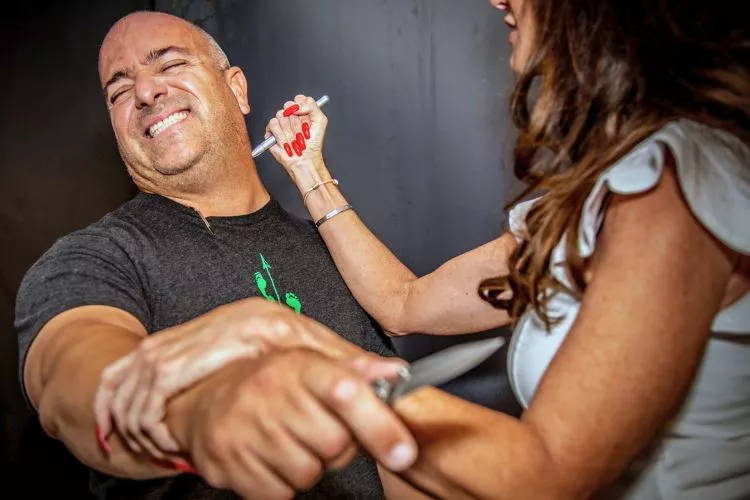
Here’s a detailed overview of how a tactical pen can serve as a self-defense tool:
Discreet yet Durable
Tactical pens, at first glance, resemble an ordinary writing instrument. This discreet appearance allows them to be carried around unnoticed, available readily in situations where other larger, obvious self-defense tools might not be accessible or legal to carry.
Their construction, often with heavy-duty materials such as aircraft-grade aluminum, steel, or titanium, gives them strength and durability, making them capable of dealing substantial blows if needed.
Self-Defense Features
Most tactical pens incorporate features specifically designed for self-defense:
- Strike Tip – Tactical pens commonly feature a hard, pointed tip on one end, which can be used to strike an assailant during a confrontation. A well-placed strike to a sensitive or vulnerable body part can cause considerable pain, allowing the user to escape dangerous scenarios.
- Kubotan Capabilities – When held properly (usually in a forward or reverse grip), a tactical pen can function as a kubotan, a self-defense tool often used in martial arts, to apply pressure on sensitive points of an attacker’s body. This allows for control techniques or compliance tactics, giving the user an advantage in defensive situations.
- DNA Catcher – Some models of tactical pens are equipped with ridged or crown-like edges, designed to not only deliver painful strikes but also collect DNA samples, which could be useful for identifying attackers later.
Legal Self-Defense Tool
While laws vary, tactical pens can be legally carried in many places since they primarily function as ordinary writing utensils. This makes them a practical self-defense tool that doesn’t violate weapons laws in these locales.
Skill Requirement
Despite their potential use as a self-defense tool, successful use of a tactical pen in a crisis situation requires some training and practice. Learning where to strike (pressure points, sensitive areas), correctly handling the pen, and when to employ it—which should only be under dire threats to your safety—are essential to ensure its effectiveness.
Is Tactical Pen TSA Approved?
The Transportation Security Administration (TSA) regulates the objects allowed in carry-on and checked luggage for flights in the United States. While it is generally known that certain weapons (like guns and knives) are prohibited, whether a tactical pen is TSA-approved can be somewhat grey.
The TSA does not maintain a specific list of approved and disallowed items, and a lot depends on the interpretation of the rules by TSA officers in charge at that time. The typical legal language refers to not carrying “weapons, sharp objects, or cutting instruments in any form.”
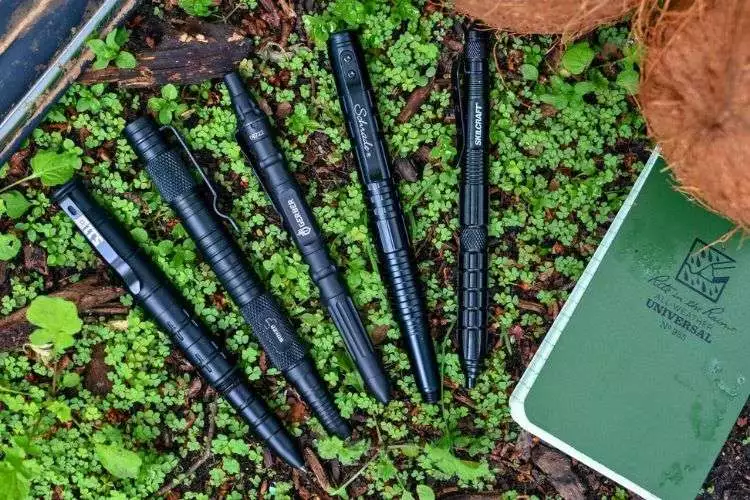
Per the above guidelines, a tactical pen, by virtue of its dual functionality as a self-defense tool, may not be allowed in a carry-on bag since it can be perceived as a weapon. There have been instances of passengers reporting that they have had their tactical pens confiscated by TSA officials.
However, tactical pens are usually permitted in checked luggage.
As per TSA guidelines, most sharp objects and potential weapons are allowed in checked luggage, provided they are secured properly to prevent injury. So, it’s typically safer to pack your tactical pen in a checked bag to prevent any last-minute issues at security checks.
While TSA rules do not explicitly mention a tactical pen, it can be classified as a weapon due to its features and purpose. It may be confiscated if in carry-on luggage.
If you’re traveling with a tactical pen, it’s generally advised to place it in your checked luggage, and it’s always a good practice to check any recent changes or specifics in the TSA rules for carrying such items.
Are Tactical Pens Legal to Carry in the USA?
As a general rule, tactical pens are legal to carry in the United States because their primary function is that of a writing instrument.
However, legalities can vary by jurisdiction and interpretation of the law, as the tactical pen’s self-defense features have the potential to categorize it as a weapon.
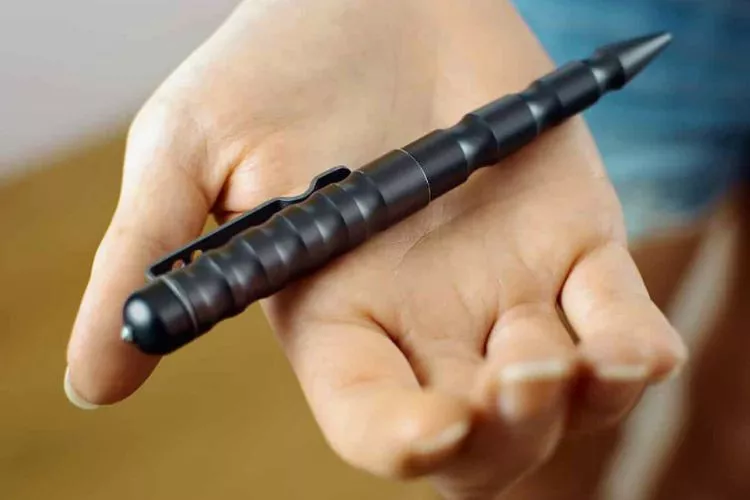
Here’s a closer look at the legal background:
Local and State Laws
While federal law does not specifically prohibit tactical pens, it’s important to remember that state and local laws might have their specifications. These laws can depend on factors such as the design of the tactical pen, intended use, and the carrier’s intent.
As with any tool that can double as a weapon, consciously concealing it to cause harm could raise legal issues.
Usage and Intent
Although tactical pens are primarily designed for writing tools, their use as a self-defense weapon is inherently part of their functionality. This is where the legality can become complicated.
An individual carrying a tactical pen intending to use it for writing is unlikely to encounter legal issues. On the contrary, if it’s proven that a person’s primary intent in carrying a tactical pen is to use it as a weapon, some legal arguments could categorize it as a concealed weapon.
Transportation: TSA and Tactical Pens
Another aspect to consider is transportation, especially air travel. The Transportation Security Administration (TSA) often confiscates tactical pens during security checks due to their potential use as a weapon.
For this reason, it’s typically safer to pack a tactical pen in checked luggage if traveling by air.
How To Use a Tactical Pen?
A tactical pen is more than just a regular pen; it combines the role of writing with the functionality of a survival or self-defense tool. Knowing how to use a tactical pen is a valuable skill to have.
This guide will help you understand everything you need to know about using a tactical pen effectively.
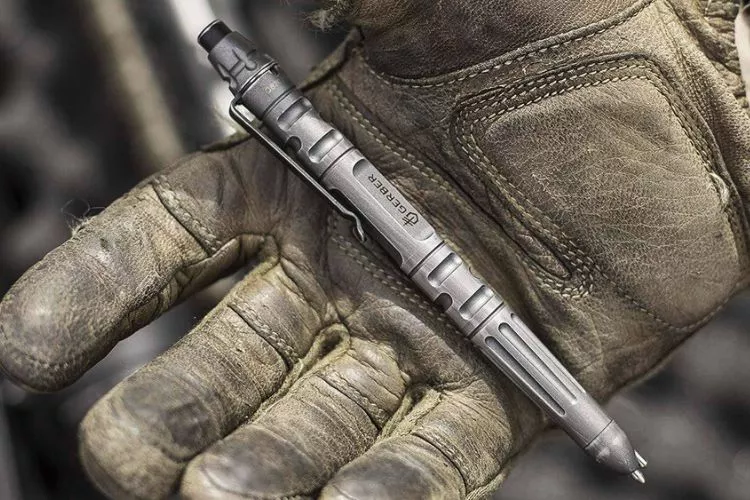
Physical Features
Firstly, it’s essential to understand the different physical features of your tactical pen.
- Writing Tip: A tactical pen allows you to write normally, like any standard pen.
- Secondary Cap: Some tactical pens come with a secondary cap covering the more harmful end for safety.
- Strike Tip: This is the potentially lethal end of the pen. It’s usually pointed and made of hard materials such as tungsten steel. This can break glass in emergencies or as a self-defense tool.
- Pocket Clip: This is handy to secure the pen to your pocket, making it readily available when needed.
- LED Flashlight: Some advanced versions include a small LED flashlight.
Fundamental Techniques
Learning to use a tactical pen effectively requires understanding and practicing a few fundamental techniques:
Holding the Pen
There are two main grip styles:
- Reverse Grip: Hold the pen such that the strike tip emerges from the palm side of your hand. This grip is useful for close combat.
- Forward Grip: Hold the pen outward from the thumb and index finger like a traditional pen. Most suitable for long-range jabbing.
Striking Method
- Slashing: A quick slashing movement can cause injury or disorient an aggressor.
- Stabbing: A forceful, directed thrust can potentially cause severe injury.
Tactical Pen Self-defense Moves
Here are a few self-defense moves that you can practice:
- Pressure Points: Use the tactical pen to strike sensitive areas such as the neck, temples, or joints.
- Eye Jab: In extreme cases, the pen can be used as a stabbing tool to the eyes.
- Hammer Fist: Hold the pen firmly and bring it down as you would with a hammer fist.
Maintenance & Care
Even though most tactical pens are extremely durable, following these steps ensures your pen lasts longer:
- Cleaning: Regularly clean the pen after use to prevent any build-ups. Especially take care of your writing tip to avoid ink clogging.
- Inspection: Routinely inspect your pen for any damages to ensure it’s ready for use when needed.
- Proper Storage: Store your tactical pen in a dry, cool place when unused. Avoid places with excessive dust.
Where to strike with a tactical pen?
A tactical pen is useful for self-defense because it concentrates the force of your strike onto a small, hard point, which means even a relatively weak person can use one to deliver a debilitating blow to an attacker.
When using a tactical pen for self-defense, you should aim for the vulnerable areas of an attacker’s body to minimize their ability to continue their assault.
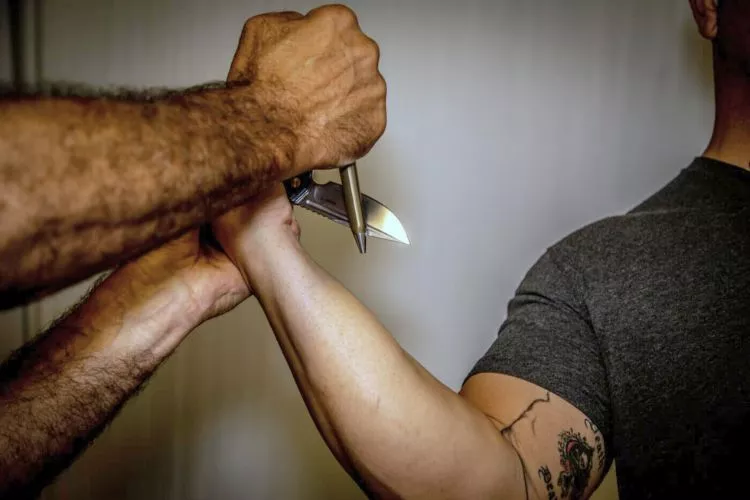
Head
- Eyes: The eyes are delicate, and attempting to strike them may cause an immediate reaction from your attacker, providing you with time to escape.
- Temples: The temples, located on the sides of the head, are vulnerable to pressure points. A well-placed strike here can be disorienting or painful.
- Nose: Striking the underside of the nose with an upward motion can cause extreme pain and potentially dissuade your attacker.
Neck
- Jugular: Striking the side of the neck can impact the jugular vein and carotid artery, which can stun your attacker by briefly cutting off blood supply to the brain.
- Throat: A hit to the throat can cause an attacker to choke and buy you some precious time.
Upper Body
- Collar Bone: The collar bone is sensitive to pain and easier to break than other bones, making it a good spot to aim for.
- Sternum: The sternum, or breastbone, can be sensitive to hard shocks, and an aggressive jab may wind your opponent.
- Solar Plexus: Located below the breastbone and above the stomach, a strong hit to the solar plexus can knock the wind out of a person and cause intense discomfort.
Lower Body
- Groin: Due to its sensitivity, the groin is a prime target when defending yourself.
- Knee: Striking the side of the knee can cause destabilization, potentially causing your attacker to fall.
- Shins and Feet: These areas are sensitive to pain due to the proximity of nerves and bones to the skin. Striking here can cause sharp pain.
Where do you keep tactical pens?
A tactical pen should be kept in an easily accessible location to provide quick access when needed for emergencies or self-defense. Here are some suggestions for where to keep your tactical pens:
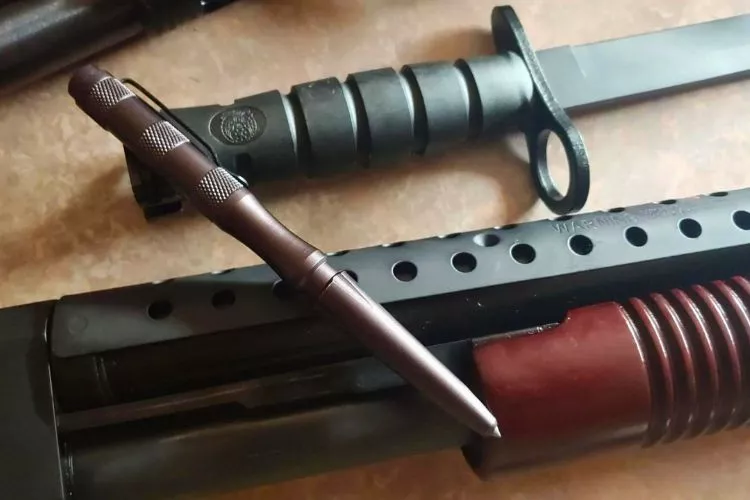
At Home or Work
- Desk or Workspace: Keep your tactical pen within arm’s reach on your desk or in a designated spot in your office.
- Nightstand: Placing the tactical pen on a nightstand can be an effective precaution for nighttime emergencies.
- Entryway: Keep the pen near your home’s entryway, so you can easily access it when coming or going.
- Emergency Kit: Include a tactical pen in your home and/or workplace emergency kits to have additional safety tools at your disposal.
On Your Person
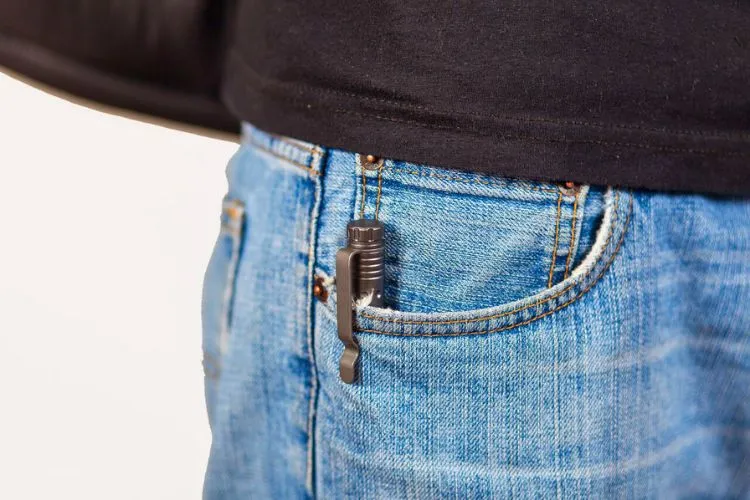
- Pocket: With a pocket clip, you can securely attach the tactical pen to your pants or shirt pocket, ensuring it always remains within easy reach.
- Keychain: Some tactical pens are designed with an attachment point for a keychain, making it convenient to carry around with your keys.
- Bag or Purse: Keeping a tactical pen in your bag or purse can be useful, but ensure the pen is in an easily-reachable compartment or secure pocket to prevent it from getting lost or buried.
- Belt Clip or Holster: Some tactical pens come with built-in clips or can be kept in a custom pen holster for those who prefer to secure the pen to their belt.
In Your Vehicle
- Center Console: Keep the pen within easy reach in your car’s center console, so you can access it in a hurry if required.
- Glove Compartment: Although not as easily accessible as the center console, the glove compartment can still be a suitable place to keep your tactical pen.
- Driver-side Door Pocket: Utilize the pocket or storage compartment on the driver-side door to store your pen for easy access.
What is the difference between a tactical pen and a Kubaton?
A Tactical Pen and a Kubaton are two different self-defense tools with distinct features:
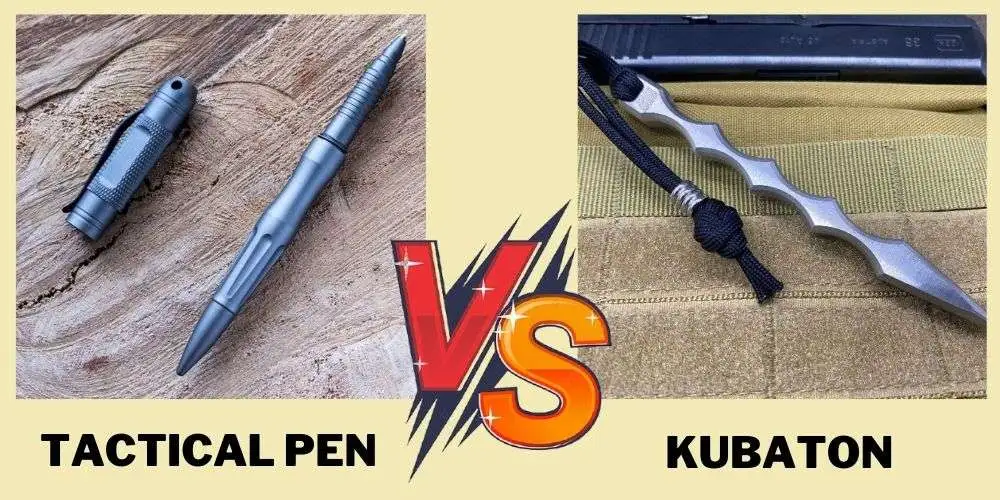
- Tactical Pen: Tactical pens, primarily designed for writing, double up as concealed weapons. These pens are made from high-tensile strength materials, providing durability. One end of the pen is typically pointed, sharp enough to inflict damage when required. These pens often come with other tools like glass breakers, flashlights, or DNA catchers.
- Kubaton: A Kubaton, on the other hand, is a straightforward self-defense tool designed explicitly for this purpose. Commonly manufactured from hard plastic or metal, they are small rod-like devices, usually 5-6 inches long. Their primary purpose is to amplify the force of your strike when you hit an attacker.
Ultimately, a tactical pen and a Kubaton serve similar purposes – to help protect yourself. The significant difference is that a tactical pen is more of a multi-tool and can be used for regular tasks, more discreet and hence easier to carry around.
Kubatons are more specialized, yielding higher impact but could draw more attention due to their martial intent.
Conclusion:
In conclusion, a tactical pen can be considered a weapon, although this isn’t its primary function. Its robust construction and concealed features make it a potent self-defense tool if the situation requires it.
However, it’s also a functioning writing instrument and often incorporates other useful tools, allowing it to blend seamlessly into everyday life.
This dual-purpose tactical pen design makes it an advantageous accessory, providing both utility and security in a discreet package. Always remember that any tool, irrespective of design, should be used responsibly.


